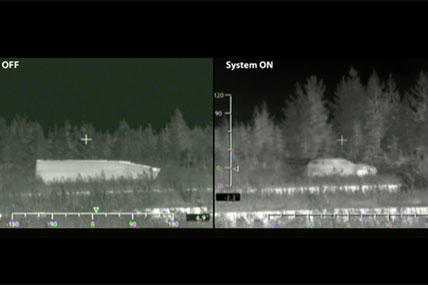New stealth technology makes airplanes invisible not only to radar, it renders them hidden to the human eye as well -- just like an invisibility cloak in a Hollywood sci-fi thriller.
News reports from China last week touted the country's work on a "cloaking" technology that uses a hexagonal array of glass-like panels to bend light around an object, obscuring it from view as though hidden by an invisibility cloak. Experts say the technology is legit -- and not unlike American and European projects from the past few years.
"The general public … might not hear about how far the U.S. has really come, because it is and should remain classified," firearms expert Chris Sajnog, a former Navy SEAL, told FoxNews.com. "Other countries are still playing catch-up -- but they're closing the gap."
But while classified work progresses, several public projects from universities and military supply companies show just how real this futuristic technology is.
How to disappear completely
Professor Chen Hongsheng at China's Zhejiang University demonstrated a device that made a fish invisible and a cat disappear, according to the South China Morning Post, a Hong Kong daily.
The professor's team is one of 40 funded by the Chinese government during the last three years, the paper reported. Some projects use materials that shuttle light away from an object; alternatives create electromagnetic fields that bend it away -- truly high-tech camouflage.
"The idea isn't new, but materials enabling the technology are becoming more available," David R. Ricketts, professor of engineering at North Carolina State University, told FoxNews.com. "It's like we see in the movies. If you tape a picture of an empty hallway to a security camera, the person looking at the camera sees an empty room -- even though you could be walking through the hallway. The ‘cloaking' approach simply takes the light on one side of the object and transmits it on the other so that you don't see the object in between."
Another Chinese professor, Ma Yungui, an optical engineer at Zhejiang University, is working on a device that prevents objects from being detected by heat sensors or metal detectors, the Post said. As small as a matchbox, it interferes with infrared camera detection, too -- allowing troops to move secretly in the night.
The Chinese professors did not return calls from FoxNews.com seeking comment.
"A few years ago we had a demonstration of these technologies here in San Diego," Sanjog said in an email. "The mirrors currently being used are large and easily detectable, while the use of wavelengths is limited to a very narrow spectrum, i.e. visible light, but not radar or thermal. Also, both of these technologies only work well when viewed from one angle, and in warfare your security is nothing if it's not 360."
Major arms developers such as BAE Systems readily acknowledge work on this kind of technology, such as the Adaptiv program, which aims to hide armored vehicles.
"The U.S. military is among many who have expressed interest in Adaptiv, which could be transferred to other platforms, such as ships and helicopters," said Mike Sweeney, a spokesman for BAE.
Pixel perfect
BAE's technology, similar to what the Chinese are now touting, deploys sheets of hexagonal "pixels" that can change temperature very rapidly. On-board cameras pick up the scenery and display it on the vehicle, which can allow a moving tank to match its surroundings.
Research is concentrated mainly on the infrared spectrum, a pressing concern for the Swedish government group funding the work. But BAE has combined its pixels with technologies that camouflage other parts of the electro-magnetic spectrum to provide all-round stealth.
But most camouflage used by the military is not as high-tech as these tools. Take for example the "ghilie suit," a garment designed to resemble heavy foliage and popular with the military and hunters.
"As a former lead instructor for the Navy SEAL sniper program, I've taught many of our current warriors the art of passive camouflage. For example, wearing a well-made ghillie suit in the proper environment can render its user virtually invisible, and this is a cloaking device that works 360, with no batteries needed," Sajnog said.
Some experts dispute that these new technologies can work in battlefield conditions at all.
"Invisibility cloak is a poorly chosen term," Thomas Way, associate professor of computing science at Villanova University, wrote to FoxNews.com in an email. "Invisible to what? We already have stealth aircraft that are invisible to radar (usually), but there is absolutely no way given our current understanding of physics that something could be made invisible to the naked eye."
"If that's what they are claiming, it's a hoax."
Don't Miss a Single Military.com Story
To read the full article and get exclusive benefits, sign up today.
It’s FREE
Why am I seeing this? Visit our FAQs


























